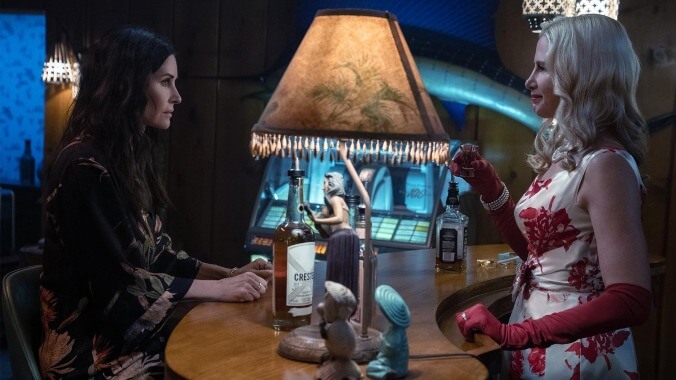Starz’s Shining Vale wrings frights and laughs from generations of feminine ideals
The new Starz series has all of the best horror elements: a haunted house, a descent into madness, sex, drugs, Christianity, and Courteney Cox

Starz’s Shining Vale boasts all of the best horror elements: a haunted house, a descent into madness, gaslighting, sex, drugs, Christianity, and Courteney Cox. As Patricia (or Pat), Cox is the flailing and failing matriarch of the Phelps family—unhappy in her marriage, disconnected from her kids, and blocked in her career as a romance novelist. In search of a fresh start after her affair with the handyman, Pat moves with her family—husband Terry (Greg Kinnear) and teenage children Gaynor (Gus Birney) and Jake (Dylan Gage)—from New York to a rather foreboding house in Connecticut.
On the way, Patricia starts seeing things, including a ’50s housewife named Rosemary. As the anachronistic homemaker, Mira Sorvino delivers a winning combination of faux naivete, evil, and playfulness. Shining Vale really gets going as the two fiftysomething women get better acquainted, leveraging a classic deal-with-the-devil plot to explore what it is to be a woman today.
At the start, Pat appears to be a cautionary tale about all the ways feminism purportedly fails women. She wears baggy clothes, never cooks, swears constantly, and, of course, cheats on her husband. Pat isn’t experiencing freedom but sadness. Her daughter communicates with her solely by yelling, and her son is so socially inept, he can’t even make eye contact with her. In couples therapy with Terry, Pat admits to being depressed and is soon popping “mother’s little helpers” like the housewives of old. But when Pat starts taking some pages from Rosemary’s figurative playbook—wearing form-fitting clothes, smoking, and cooking—the whole family is suddenly happier. They like being taken care of in these ways, and there’s a part of Pat (and perhaps the audience) that wonders if this older version of femininity isn’t more fulfilling for mothers and families alike.
But Pat has to give up who she is to make this bargain, and her willingness to erase herself shows how powerless she really is, even as a modern woman. After all, she isn’t living in some feminist utopia where breaking from restrictive gender norms is rewarded or otherwise compensated. Take cooking—at the start, the Phelps family just eats takeout. Terry doesn’t cook and neither do either of the teenagers, even though they clearly could. The only reason the duty falls to Pat is because, well, that’s what moms are supposed to do—even today, feminism notwithstanding.
In therapy, Pat’s emotions are quickly medicated away, but when Terry’s depressed, the therapist advises him to work through it. Pat calls bullshit and while the double standard is clear, acknowledging it doesn’t make it go away. The medical establishment’s history of treating women as hysterical looms throughout the show, not just in Pat’s story but that of her mother, Joan (Judith Light). Light always pops on screen, and she does so here as a woman who was committed against her will because of her psychosis. Joan is hyper-feminine—we’re talking huge false eyelashes and big, flowing blond hair—but she’s constantly complaining of the electricity shot through her body and the pills (particularly the lithium) she was forced to take. There’s no winning for Joan, no solace to be found.
Going down the matriarchal line, Pat’s daughter Gaynor does not fare much better. Pat starts off encouraging her to dress less provocatively, but when Gaynor joins the chastity club—for a neighbor boy, no less—Pat’s not any happier, accusing her daughter of being brainwashed. It’s possible Shining Vale is setting up Gaynor’s budding Christianity as a protective factor against the evil forces at work; Gaynor’s baptism and a necklace she receives from her godmother do seem to help.
But even as the show establishes these pillars of “good” womanhood—faith, domesticity, even sanity—it’s clear Shining Vale isn’t really advocating for them. Gaynor’s never serious about giving up sex (or her crude humor). While she does learn some things from exploring spirituality, if she survives the season, it won’t be because faith transformed her. Joan’s femininity actually makes her more vulnerable, and the show is full of jokes about Rosemary’s brand of domesticity. Yes, she cooks, but her food is the worst of the ’50s—all corn-flake casseroles and gelatins. The other characters view Joan’s smoking as the unhealthy, passé habit it is, and her penchant for dramatic entrances and playing with people’s emotions just cause trouble for Pat.
Of course, the major strike against Rosemary is her violent impulses. Did she really die by suicide? Murder others? Probably! She certainly didn’t have a lot of tools to fight back against an abusive husband in her day. She wasn’t able to work outside the house, so didn’t even have her own money. So while there are aspects of Rosemary’s brand of womanhood that are still appealing today, Shining Vale makes it clear that the old model is worse—and the flirting with it, the nostalgia for it, is the stuff of horror, at least if you’re coming at it from a woman’s perspective.
The best scary stories find their frights in real-life fears, and the genre is rich with ones that explore the feminine grotesque—Black Swan and Rosemary’s Baby come to mind. Shining Vale brings humor to that equation, both laughing at and dramatizing the scary aspects of gender norms. The result is a show that’s smart enough to keep viewers guessing as it pokes fun at modern society, its characters, and even its audience.